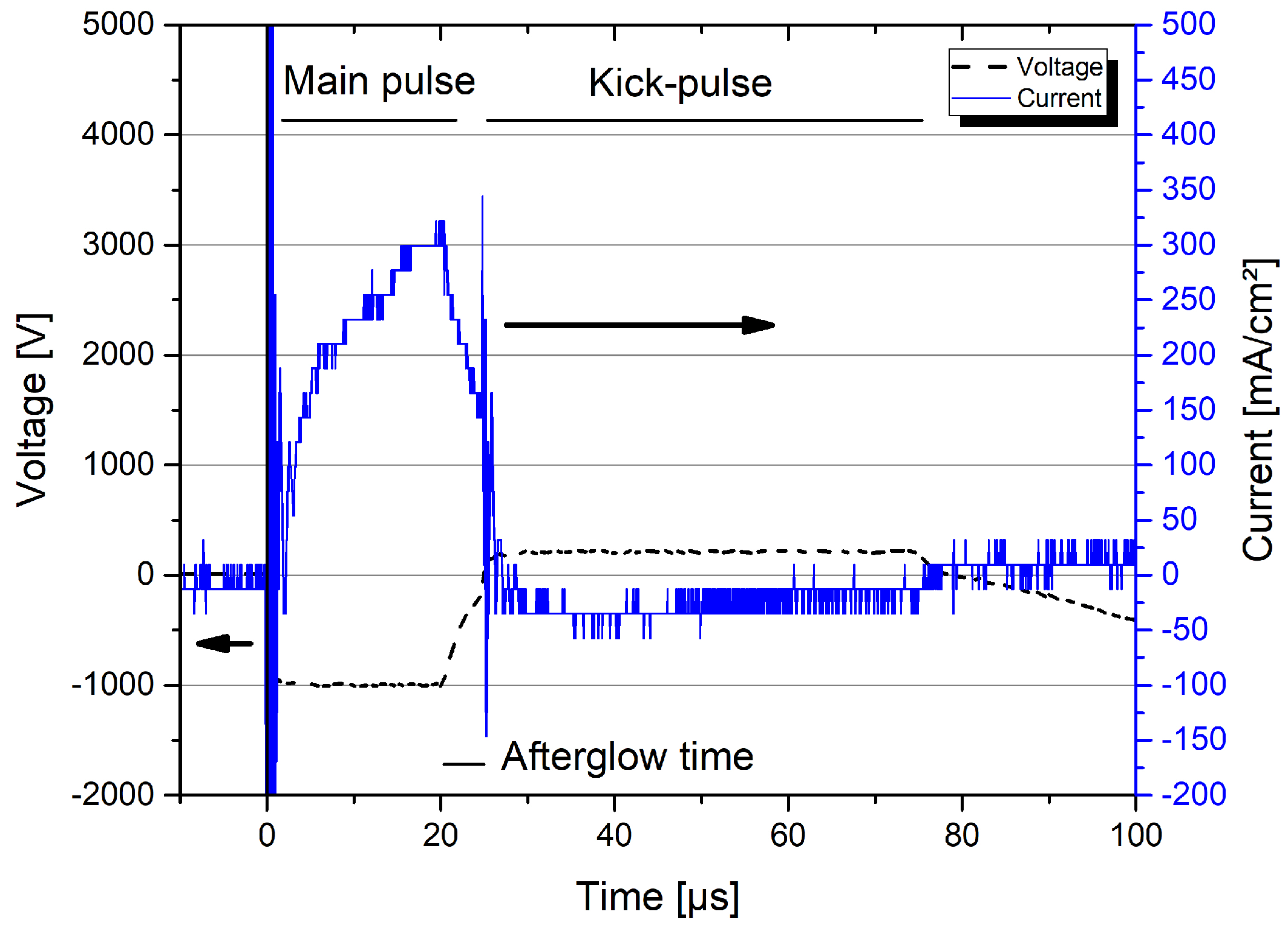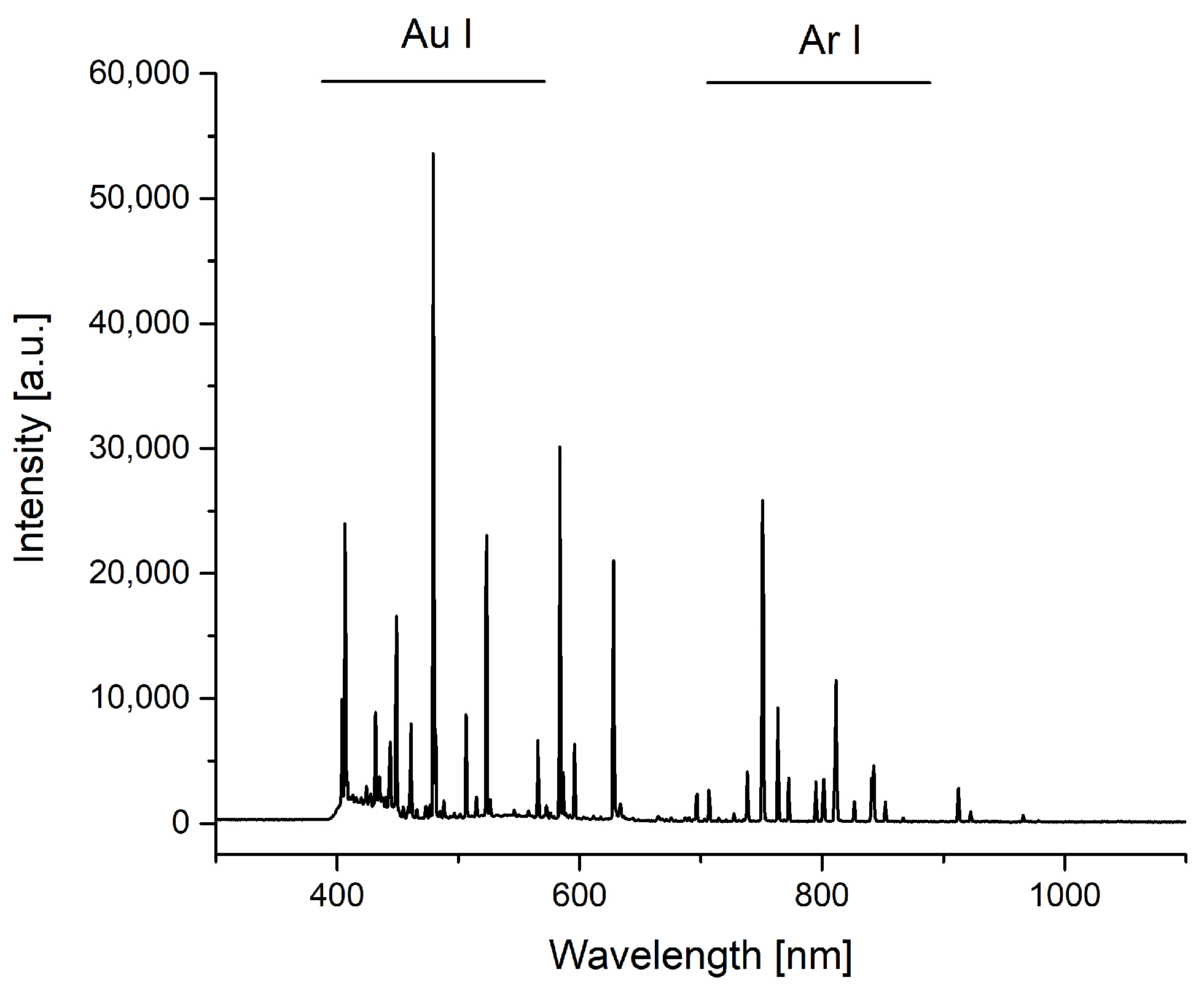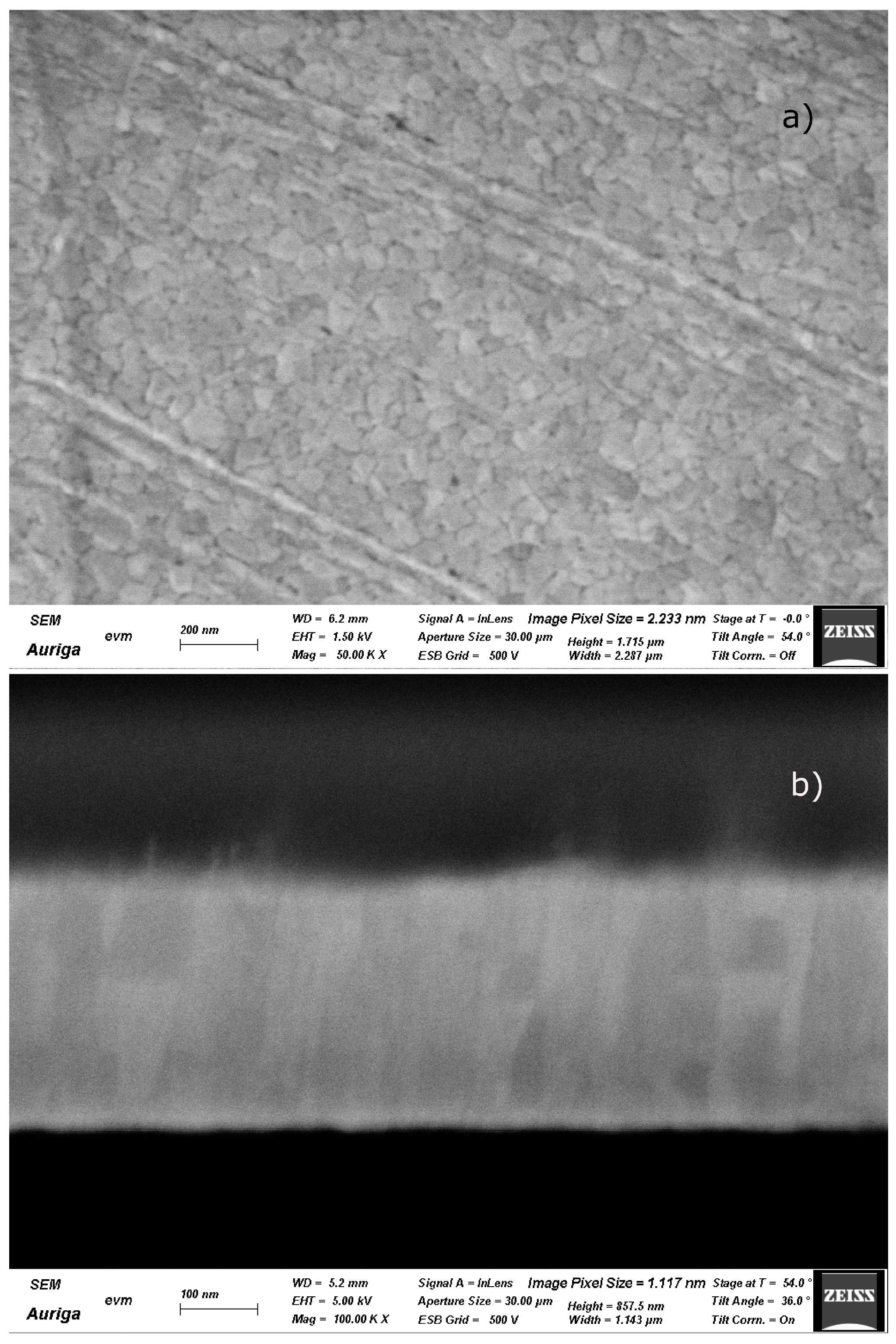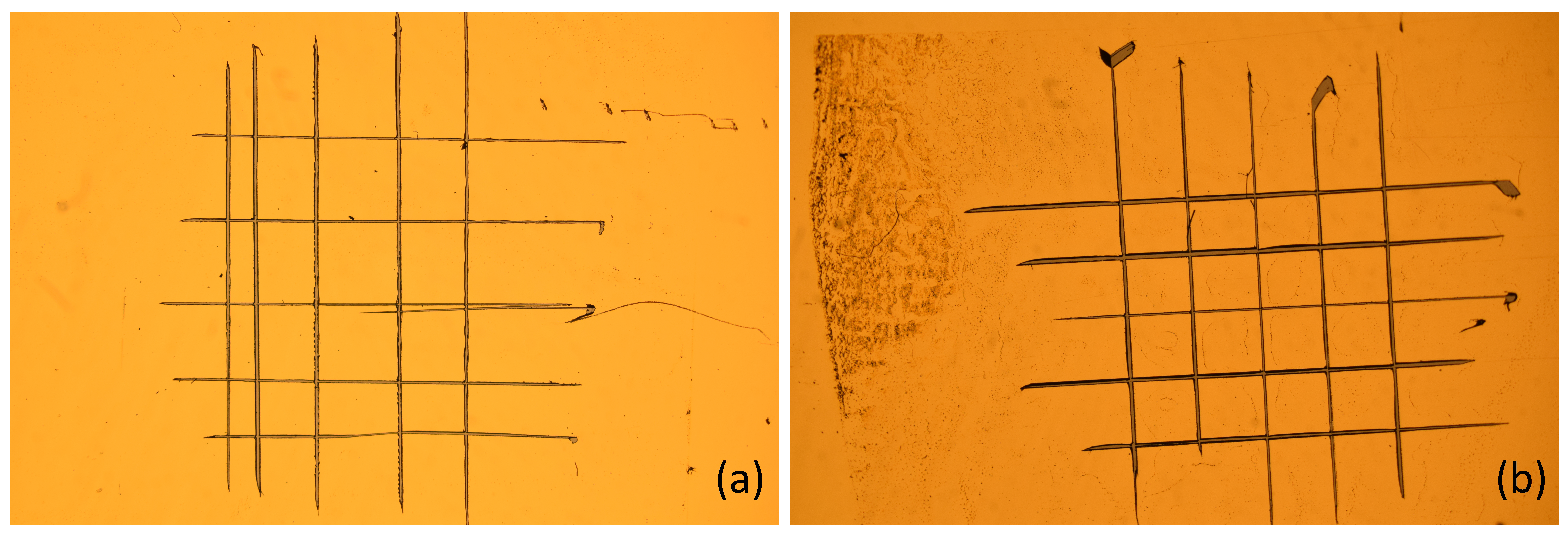Adhesion of HIPIMS-Deposited Gold to a Polyimide Substrate
Abstract
1. Introduction
1.1. Neural Implants
1.2. HIPIMS
2. Materials and Methods
2.1. Polyimide
2.2. Gold Deposition
2.3. Measuring Equipment
2.4. Cut Test for Evaluation of Adhesion
3. Results
3.1. Current Pulse
3.2. Spectrum
3.3. Surface and Cross-Cut Morphology of the Gold Layers
3.4. Scratch Test
4. Conclusions
Author Contributions
Funding
Institutional Review Board Statement
Informed Consent Statement
Data Availability Statement
Acknowledgments
Conflicts of Interest
Abbreviations
| ABS | Acrylonitrile butadiene styrene |
| ECoG | Electrocorticography |
| FIB | Focused Ion Beam |
| HIPIMS | High Power Impulse Magnetron Sputtering |
| NIST | National Institute of Standards and Technology |
| OES | Optical Emission Spectroscopy |
| PET | Polyethylene terephthalate |
| PI | Polyimide |
| PPX-C | Parylene-C |
| PVD | Physical Vapour Deposition |
| SEM | Scanning Electron Microscope |
| SU-8 | Polymer |
References
- Nandra, M.S.; Lavrov, I.A.; Edgerton, V.R.; Tai, Y. A parylene-based microelectrode array implant for spinal cord stimulation in rats. In Proceedings of the 2011 IEEE 24th International Conference on Micro Electro Mechanical Systems, Cancun, Mexico, 23–27 January 2011; pp. 1007–1010. [Google Scholar]
- Biswas, S.; Sikdar, D.; Das, D.; Mahadevappa, M.; Das, S. PDMS based multielectrode arrays for superior in-vitro retinal stimulation and recording. Biomed. Microdevices 2017, 19, 1–14. [Google Scholar] [CrossRef] [PubMed]
- Rousche, P.J.; Pellinen, D.S.; Pivin, D.P.; Williams, J.C.; Vetter, R.J.; Kipke, D.R. Flexible polyimide-based intracortical electrode arrays with bioactive capability. IEEE Trans. Biomed. Eng. 2001, 48, 361–371. [Google Scholar] [CrossRef] [PubMed]
- Merriam, S.M.E.; Srivannavit, O.; Gulari, M.N.; Wise, K.D. A three-dimensional 64-site folded electrode array using planar fabrication. J. Microelectromech. Syst. 2011, 20, 594–600. [Google Scholar] [CrossRef]
- Seymour, J.P.; Elkasabi, Y.M.; Chen, H.; Lahann, J.; Kipke, D.R. The insulation performance of reactive parylene films in implantable electronic devices. Biomaterials 2009, 30, 6158–6167. [Google Scholar] [CrossRef]
- Huang, R.K.-J. Flexible Neural Implants. Ph.D. Thesis, California Institute of Technology, Pasadena, CA, USA, 2011. [Google Scholar]
- Chen, C.; Chuang, S.; Su, H.; Hsu, W.; Yew, T.; Chang, Y.; Yeh, S.; Yao, D. A three-dimensional flexible microprobe array for neural recording assembled through electrostatic actuation. Lab Chip 2011, 11, 1647–1655. [Google Scholar] [CrossRef]
- Kim, E.G.R.; John, J.K.; Tu, H.; Zheng, Q.; Loeb, J.; Zhang, J.; Xu, Y. A hybrid silicon–paryleneneural probe with locally flexible regions. Sens. Actuators B Chem. 2014, 195, 416–422. [Google Scholar] [CrossRef]
- Shin, S.; Kim, J.; Jeong, J.; Gwon, T.M.; Lee, S.; Kim, S.J. Novel four-sided neural probe fabricated by a thermal lamination process of polymer films. J. Neurosci. Methods 2017, 278, 25–35. [Google Scholar] [CrossRef]
- Tsang, W.M.; Je, M. Flexible electrode for implantable neural devices. Neural Comput. Neural Devices Neural Prosthes. 2014, 10, 121–156. [Google Scholar]
- Williamson, A.; Ferro, M.; Leleux, P.; Ismailova, E.; Kaszas, A.; Doublet, T.; Quilichini, P.; Rivnay, J.; Rózsa, B.; Katona, G. Localized neuron stimulation with organic electrochemical transistors on delaminating depth probes. Adv. Mater. 2015, 27, 4405–4410. [Google Scholar] [CrossRef]
- Lecomte, A.; Degache, A.; Descamps, E.; Dahan, L.; Bergaud, C. In vitro and in vivo biostability assessment of chronically-implanted Parylene C neural sensors. Sens. Actuators B Chem. 2017, 251, 1001–1008. [Google Scholar] [CrossRef]
- Baek, D.; Lee, E.; Moon, J.; Choi, J.H.; Pak, J.J.; Lee, S. Polyimide-based multi-channel arrayed electrode for measuring EEG signal on the skull of mouse. In Proceedings of the 2009 Annual International Conference of the IEEE Engineering in Medicine and Biology Society, Minneapolis, MN, USA, 2–6 September 2009; pp. 7022–7025. [Google Scholar]
- Márton, G. Development and Characterization of Novel Microelectrode Arrays for Neurophysiology. Ph.D. Thesis, Semmelweis University, Budapest, Hungary, 2015. [Google Scholar]
- Kireev, D.; Montes, V.R.; Stevanovic, J.; Srikantharajah, K.; Offenhäusser, A. N3-MEA probes: Scooping neuronal networks. Front. Neurosci. 2019, 13, 320. [Google Scholar] [CrossRef] [PubMed]
- Gymama, S.; Matthew, R.; Joel, T.; Chen, J. Neuroelectronic device process development and challenge. In Optical Microlithography XXX; Andreas, E., Jongwook, K., Eds.; SPIE: Bellingham, WA, USA, 2017; Volume 10147, p. 101470W. [Google Scholar]
- Tolstosheeva, E.; Hoeffmann, J.; Pistor, J.; Rotermund, D.; Schellenberg, T.; Boll, D.; Hertzberg, T.; Gordillo-Gonzalez, V.; Mandon, S.; Peters-Drolshagen, D.; et al. Towards a wireless and fully-implantable ECoG system. In Proceedings of the 2013 Transducers & Eurosensors XXVII: The 17th International Conference on Solid-State Sensors, Actuators and Microsystems (TRANSDUCERS & EUROSENSORS XXVII), Barcelona, Spain, 16–20 June 2013; pp. 384–387. [Google Scholar]
- Rodri, F.J.; Ceballos, D.; Schu, M.; Valero, A.; Valderrama, E.; Stieglitz, T.; Navarro, X. Polyimide cuff electrodes for peripheral nerve stimulation. J. Neurosci. Methods 2000, 98, 105–118. [Google Scholar]
- Tintelott, M.; Schander, A.; Lang, W. Understanding Electrical Failure of Polyimide-Based Flexible Neural Implants: The Role of Thin Film Adhesion. Polymers 2022, 14, 3702. [Google Scholar] [CrossRef] [PubMed]
- Deku, F.; Frewin, C.L.; Stiller, A.; Cohen, Y.; Aqeel, S.; Joshi-Imre, A.; Black, B.; Gardner, T.J.; Pancrazio, J.J.; Cogan, S.F. Amorphous silicon carbide platform for next generation penetrating neural interface designs. Micromachines 2018, 9, 480. [Google Scholar] [CrossRef] [PubMed]
- Schander, A.; Stemmann, H.; Tolstosheeva, E.; Roese, R.; Biefeld, V.; Kempen, L.; Kreiter, A.K.; Lang, W. Design and fabrication of novel multi-channel floating neural probes for intracortical chronic recording. Sens. Actuators A Phys. 2016, 247, 125–135. [Google Scholar] [CrossRef]
- Nwankire, C.E.; Venkatanarayanan, A.; Forster, R.J.; Ducrée, J. Enhanced gold-to-polymer adhesion for integrated electrochemical biosensing on cost-efficient lab-on-achip cartridges. In Proceedings of the 19th International Conference on Miniaturized Systems for Chemistry and Life Sciences, Gyeongju, Republic of Korea, 25–29 October 2015. [Google Scholar]
- Moazzez, B.; O’Brien, S.M.; Merschrod, E. Improved adhesion of gold thin films evaporated on polymer resin: Applications for sensing surfaces and MEMS. Sensors 2013, 13, 7021–7032. [Google Scholar] [CrossRef] [PubMed]
- Von Metzen, R.P.; Stieglitz, T. The effects of annealing on mechanical, chemical, and physical properties and structural stability of Parylene C. Biomed. Microdevices 2013, 15, 727–735. [Google Scholar] [CrossRef]
- Li, W.; Rodger, D.; Menon, P.; Tai, Y. Corrosion behavior of parylene-metal-parylene thin films in saline. ECS Trans. 2008, 11, 1. [Google Scholar] [CrossRef]
- Wu, P.Y.; Lin, C.H.; Chen, C.-M. Study of surface metallization of polyimide film and interfacial characterization. Metals 2017, 7, 189. [Google Scholar] [CrossRef]
- Yoon, S.S.; Kim, D.O.; Park, S.C.; Lee, Y.K.; Chae, H.Y.; Jung, S.B.; Nam, J.-D. Direct metallization of gold patterns on polyimide substrate by microcontact printing and selective surface modification. Microelectron. Eng. 2008, 85, 136–142. [Google Scholar] [CrossRef]
- Huang, S.-E.; Shen, F.-Y.; Dow, W.-P. Polyimide metallization using nickel nano-film as both catalyst and barrier layer of copper electroless deposition. J. Electrochem. Soc. 2019, 166, D843. [Google Scholar] [CrossRef]
- Ma, Q.; Moldovan, N.; Mancini, D.C.; Rosenberg, R.A. Synchrotron-radiation-induced, selective-area deposition of gold on polyimide from solution. Appl. Phys. Lett. 2000, 76, 2014–2016. [Google Scholar] [CrossRef]
- Zahavi, J.; Rotel, M.; Katz, D.; Levine, S. UV Laser-Induced Metallization of Polyimide from Electroplating Solution. Met. Plast. 1 1989, 55–68. [Google Scholar]
- Pflüger, S.; Wehner, M.; Jansen, F.; Kruck, T.; Lupp, F. Deposition of gold on polyimide from solutions. Appl. Surf. Sci. 1995, 86, 504–508. [Google Scholar] [CrossRef]
- Basarir, F.; Yoon, T.-H. Preparation of gold patterns on polyimide coating via layer-by-layer deposition of gold nanoparticles. J. Colloid Interface Sci. 2010, 352, 11–18. [Google Scholar] [CrossRef] [PubMed]
- Kong, Y.; Shao, J.; Wang, W.; Chen, Z.; Chu, H. Surface modification and metallization of polyimide using gold colloids as a seed layer. J. Appl. Polym. Sci. 2009, 111, 2044–2048. [Google Scholar] [CrossRef]
- Melentiev, R.; Yudhanto, A.; Tao, R.; Vuchkov, T.; Lubineau, G. Metallization of polymers and composites: State-of-the-art approaches. Mater. Des. 2022, 110958. [Google Scholar] [CrossRef]
- Kouznetsov, V.; Macak, K.; Schneider, J.M.; Helmersson, U.; Petrov, I. A novel pulsed magnetron sputter technique utilizing very high target power densities. Surf. Coatings Technol. 1999, 122, 290–293. [Google Scholar] [CrossRef]
- Mozgrin, D.V.; Fetisov, I.K.; Khodachenko, G.V. High-current low-pressure quasi-stationary discharge in a magnetic field: Experimental research. Plasma Phys. Rep. 1995, 21, 400–409. [Google Scholar]
- Ehiasarian, A.P. High-power impulse magnetron sputtering and its applications. Pure Appl. Chem. 2010, 82, 1247–1258. [Google Scholar] [CrossRef]
- Gudmundsson, J.T.; Brenning, N.; Lundin, D.; Helmersson, U. High power impulse magnetron sputtering discharge. J. Vac. Sci. Technol. A Vac. Surfaces Film. 2012, 30, 030801. [Google Scholar] [CrossRef]
- Eichenhofer, G.; Fernandez, I.; Wennberg, A. Industrial Use of HiPIMS up to Now and a Glance into the Future, A Review by a Manufacturer Introduction of the hiP-V hiPlus Technology. Univers. J. Phys. Appl. 2017, 11, 73–79. [Google Scholar] [CrossRef]
- Bandorf, R.; Waschke, S.; Carreri, F.C.; Vergöhl, M.; Grundmeier, G.; Bräuer, G. Direct metallization of PMMA with aluminum films using HIPIMS. Surf. Coatings Technol. 2016, 290, 77–81. [Google Scholar] [CrossRef]
- Kelly, P.J.; Barker, P.M.; Ostovarpour, S.; Ratova, M.; West, G.T.; Iordanova, I.; Bradley, J.W. Deposition of photocatalytic titania coatings on polymeric substrates by HiPIMS. Vacuum 2012, 86, 1880–1882. [Google Scholar] [CrossRef]
- Chen, Y.-H.; Hsu, C.-C.; He, J.-L. Antibacterial silver coating on poly (ethylene terephthalate) fabric by using high power impulse magnetron sputtering. Surf. Coatings Technol. 2013, 232, 868–875. [Google Scholar] [CrossRef]
- Zhang, D.; Zuo, X.; Wang, Z.; Li, H.; Chen, R.; Wang, A.; Ke, P. Comparative study on protective properties of CrN coatings on the ABS substrate by DCMS and HiPIMS techniques. Surf. Coatings Technol. 2020, 394, 125890. [Google Scholar] [CrossRef]
- Bandorf, R.; Waschke, S.; Vergöhl, M.; Grundmeier, G.; Bräuer, G. Haftfeste Direktmetallisierung von Kunststoffen durch Beschichtung mit Ionen: Neue Anwendungsfelder für HIPIMS Technologie. Vak. Forsch. Prax. 2015, 27, 18–23. [Google Scholar] [CrossRef]
- Fantz, U. Basics of plasma spectroscopy. Plasma Sources Sci. Technol. 2006, 15, S137. [Google Scholar] [CrossRef]
- Wu, B.; Haehnlein, I.; Shchelkanov, I.; McLain, J.; Patel, D.; Uhlig, J.; Jurczyk, B.; Leng, Y.; Ruzic, D.N. Cu films prepared by bipolar pulsed high power impulse magnetron sputtering. Vacuum 2018, 150, 216–221. [Google Scholar] [CrossRef]
- NIST Atomic Spectra Database. Available online: https://physics.nist.gov/PhysRefData/ASD/lines_form.html (accessed on 6 January 2023).




Disclaimer/Publisher’s Note: The statements, opinions and data contained in all publications are solely those of the individual author(s) and contributor(s) and not of MDPI and/or the editor(s). MDPI and/or the editor(s) disclaim responsibility for any injury to people or property resulting from any ideas, methods, instructions or products referred to in the content. |
© 2023 by the authors. Licensee MDPI, Basel, Switzerland. This article is an open access article distributed under the terms and conditions of the Creative Commons Attribution (CC BY) license (https://creativecommons.org/licenses/by/4.0/).
Share and Cite
Guljakow, J.; Lang, W. Adhesion of HIPIMS-Deposited Gold to a Polyimide Substrate. Coatings 2023, 13, 250. https://doi.org/10.3390/coatings13020250
Guljakow J, Lang W. Adhesion of HIPIMS-Deposited Gold to a Polyimide Substrate. Coatings. 2023; 13(2):250. https://doi.org/10.3390/coatings13020250
Chicago/Turabian StyleGuljakow, Jürgen, and Walter Lang. 2023. "Adhesion of HIPIMS-Deposited Gold to a Polyimide Substrate" Coatings 13, no. 2: 250. https://doi.org/10.3390/coatings13020250
APA StyleGuljakow, J., & Lang, W. (2023). Adhesion of HIPIMS-Deposited Gold to a Polyimide Substrate. Coatings, 13(2), 250. https://doi.org/10.3390/coatings13020250




